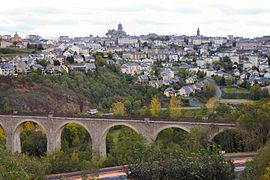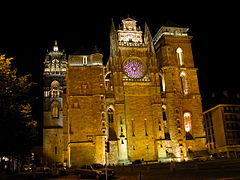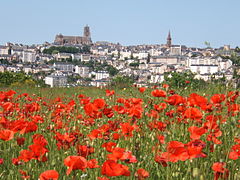Rodez
Rodez | |
|---|---|
Prefecture and commune | |
 A general view of Rodez. | |
| Coordinates: 44°21′02″N 2°34′30″E / 44.3506°N 2.5750°E | |
| Country | France |
| Region | Occitanie |
| Department | Aveyron |
| Arrondissement | Rodez |
| Canton | Rodez-1 Rodez-2 Rodez-Onet |
| Intercommunality | Rodez Agglomération |
| Government | |
| • Mayor (2014-2020) | Christian Teyssèdre[1] |
| Area 1 | 11.18 km2 (4.32 sq mi) |
| Population (2014) | 24,088 |
| • Density | 2,200/km2 (5,600/sq mi) |
| Demonym | Ruthénois |
| Time zone | UTC+01:00 (CET) |
| • Summer (DST) | UTC+02:00 (CEST) |
| INSEE/Postal code | 12202 /12000 |
| Elevation | 501–643 m (1,644–2,110 ft) (avg. 572 m or 1,877 ft) |
| Website | http://www.ville-rodez.fr/ |
| 1 French Land Register data, which excludes lakes, ponds, glaciers > 1 km2 (0.386 sq mi or 247 acres) and river estuaries. | |
Rodez (Occitan: Rodés) is a commune in southwestern France in the department of Aveyron, of which it is its prefecture. It is in the region of Occitanie.
It was the capital of Rouergue, a former French province. Rodez is also the capital of 3 cantons: Rodez-1, Rodez-2 and Rodez-Onet.
History
[change | change source]Existing from at least the 5th century BC, Rodez was founded by Celtic people, the Ruteni. Here they built an oppidum (fortified place) which, after the Roman occupation, was named Segodunum ("Fortified place", "high hill"). The town later was given the name of Civitas Rutenorum ("City of the Ruteni") and then only Ruteni and, finally, Rodez.[2]
After the fall of the Western Roman Empire, the city was taken by the Visigoths and then by the Franks; in 725, the Moors took the city and destroyed the old church. Later it was occupied by the armies of the Dukes of Aquitaine and of the Counts of Toulouse. English troops occupied Rodez during the Hundred Years War.[2]
With the creation of the Aveyron department in 1790, Rodez became préfecture of the department.[3]
Geography
[change | change source]The commune of Rodez is on the western part of the central plateau (Massif Central) of France. The Aveyron river and the Auterne stream flow through the city.
Rodez has an area of 11.2 km2 (4.3 sq mi),[4] and its average altitude is 572 m (1,877 ft); at the city hall, the altitude is 627 m (2,057 ft).[5]

|
Rodez is surrounded by the communes Onet-le-Château, Sainte-Radegonde, Le Monastère and Olemps.
Climate
[change | change source]The climate of Rodez, in the Köppen climate classification, is Cfb - Oceanic climate with template summers.
Population
[change | change source]The inhabitants of Rodez are known, in French, as Ruthénois (women: Ruthénoises).[6]
With a population of 24,088,[7] Rodez has a population density of 2,155 inhabitants/km2.
Evolution of the population in Rodez

Rodez forms, together with 5 other communes, the urban area of Rodez with a population of 49,716 inhabitants (2013) and an area of 123.6 km2 (47.7 sq mi).[8] This urban area is the centre of the metropolitan area of Rodez, formed by 39 communes with a population of 85,181 inhabitants and an area of 1,066.0 km2 (411.6 sq mi).[9]
Administration
[change | change source]Rodez is the prefecture of the Aveyron department, the capital of the arrondissement of Rodez and the administrative centre (French: chef-lieu) of three cantons:
- Rodez-1, with 11,905 inhabitants (2014).
- Rodez-2, with 12,051 inhabitants (2014).
- Rodez-Onet, with 14,105 inhabitants (2014).
It is part of the intercommunality Rodez Agglomération (French: Communauté d'agglomération Rodez Agglomération).
Sister cities
[change | change source]Rodez is twinned with:[10]
Places of interest
[change | change source]Some interesting places in Rodez are:
- The Rodez Cathedral (French: Cathédrale Notre-Dame de Rodez) is a Roman Catholic cathedral; is the main religious building of the department.
- The Episcopal Palace (French: Palais épiscopal de Rodez), built in the 15th century.
- The Saint-Amans Church, built in the 12th century and then completely rebuilt from 1758 to 1761 with materials from the original building.
- The Hôtel de la préfecture, built in the first half of the 18th century. It is now home to the prefecture of the Aveyron department.
Gallery
[change | change source]-
Aveyron prefecture building.
-
Rodez cathedral.
-
Rodez cathedral by night.
-
Rodez, general view.
References
[change | change source]- ↑ "Le conseil municipal" (in French). Mairie de Millau. Archived from the original on 28 January 2017. Retrieved 17 March 2017.
- ↑ 2.0 2.1 "Son Histoire: L'Antiquité" (in French). La Ruthènoise. Archived from the original on 18 June 2012. Retrieved 27 June 2014.
- ↑ "Historique de l'Aveyron". Le SPLAF (in French). Retrieved 27 June 2014.
- ↑ "Commune de Rodez (12202)". Comparateur de territoire (in French). Institut national de la statistique et des études économiques - INSEE. Retrieved 18 March 2017.
- ↑ "Rodez". Map-France.com. Retrieved 27 June 2014.
- ↑ "Rodez (12000)" (in French). habitants.fr. Retrieved 27 June 2014.
- ↑ "Régions, départements, arrondissements, cantons et communes" (PDF). Populations légales 2014 (in French). Institut national de la statistique et des études économiques - INSEE. Retrieved 17 March 2017.
- ↑ "Unité urbaine de Rodez (12402)". Comparateur de territoire (in French). Institut national de la statistique et des études économiques - INSEE. Retrieved 18 March 2017.
- ↑ "Aire urbaine de Rodez (104)". Comparateur de territoire (in French). Institut national de la statistique et des études économiques - INSEE. Retrieved 18 March 2017.
- ↑ "Les relations internationales" (in French). Ville de Rodez. Retrieved 27 June 2014.
Related pages
[change | change source]Other websites
[change | change source]- City Council website (in French)
- Office de Tourisme - Rodez Archived 2015-02-13 at the Wayback Machine
- Rodez Agglomération (in French)








